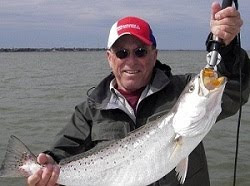Catching Speckled Trout and Redfish with Fishing Guide, Capt. Paul Marcaccio, on Galveston Bay.
Capt. Paul aims to provide each and every client with the trip and experience of a lifetime.
Saturday, May 30, 2015
Flounder at its Finest
Flounder Fishing – for Everyone
Successful flounder fishing is not for everyone. If you simply cast out the bait and wait, you may catch a flounder or two, but in general you’re in for a disappointment and frustration. Successful hook and line flounder fishing rates right at the head of the class. If you can successfully catch flounder on hook and line, you have bragging rights and should consider yourself an expert.
This writer can give a lot of tips on catching flounder, but when it comes to actually setting the hook in the mouth of a flatfish, it all boils down to two items: “Concentration and Experience”!
“It seems everyone else can catch flounder except me.” I hear that so often this time of year, when the flounder make their migratory move to the Gulf.
First off, the flounder has no swim bladder. This simply means the fish goes through life swimming or lying on or near the bottom. They are unable to suspend themselves motionless at any depth. Furthermore, it doesn’t have the fin structure nor body shape for fast swimming. It tends to move in short darts that appear to be fast, because when flounder move they raise a lot of silt off the bottom.
The fish normally feed from ambush, lying partially hidden on the bottom until food matter moves or drifts close by. The fish quickly rises off the bottom, grabs the food and sinks right back to the bottom. This is where your experience comes into play. Most fish tend to engulf the bait. The flounder instead, hold it tightly with its teeth for a few seconds before ingesting. Some marine biologist says the fish does this to kill the bait before taking it deep into its mouth.
If you try to set the hook the instant you feel a pick-up. Odds are excellent you’ll tear the hook out of the bait and give the flounder a free meal. Instead, wait approximately ten (10) seconds before striking or setting the hook.
This writer prefers to palm my reel, letting the line run lightly between my thumb and forefinger. You would be surprised at what the flounder telegraphs up the taunt line. You can feel the fish working the bait, and you can feel when the fish takes the bait deep into its mouth. That’s the moment of truth to strike and set the hook. Experience this a few times and you will never forget it………
Since flounder normally feed on matter that drifts close by, successful flounder fishermen and women are those who fish every foot of the bottom within casting range. Do this by inching the bait along the bottom. When you feel the line taunt, treat it as if a flounder has grabbed the bait and not as if the hook fouled a snag. Wait the magic ten (10) seconds before setting the hook. This tackle can be modified to be used with a float in wading depth. Rig the float to hold the bait just a few inches above the bottom. Cast up current and allow the current to carry along the float so a lot of bottom can be covered.
When a flounder takes the bait, the float will stop moving and simply lean over in the current. Wait the magical ten (10) seconds, and then set the hook. If the float starts moving against the current, you can bet money that the infamous blue crab has grabbed the bait and moved off with it.
There are a number of good terminal rigs for flounder. I prefer a slip sinker attached to the line followed by a swivel, then 18 to 24 inches of leader line (20 to 30 lbs.) followed by a wide gap (circle hook) either #2 or #3. The best bait is either live mud minnows or finger mullet. When the bay temperature cools down less than 70 degrees. Live shrimp will also work as well.
The most effective artificial lure is any soft plastic bait. Bass assassin, shrimp tail, or shad tails. Use either 1/8 to ¼ oz. lead head. I prefer the Norton lazer screw on hooks or the new Bass Assassin screw on as well. Work the bait right on the bottom with your yo-yo effect on lifting and dropping the rod tip. I prefer the new All-Pro titanium rod made by Fishing Tackle Unlimited in either 6-1/2’ or 7’. It’s called the GREEN ROD…………………..
Hopefully, these tips give you a leg up on your next successful flounder trip.
Good luck and good fishing.
See y’all outdoors on Galveston Bay.
Capt. Paul Marcaccio
Subscribe to:
Posts (Atom)
